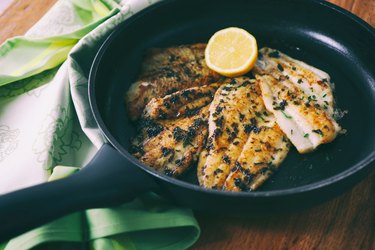
Flounder are large, flat fish found on the bottom of saltwater locations around the United States. A type of white fish, it contains very little fat and no carbohydrates. Instead, flounder is relatively protein-rich and contains some beneficial minerals.
Though an 8-ounce serving of fish is a fairly large portion, this amount provides rather low levels of nutrition. Flounder contains more than 80-percent water, reducing the overall nutritional content of the fish.
Video of the Day
Video of the Day
An 8-ounce serving of flounder contains:
- 183 calories
- 5 grams of fat
- 32 grams of protein
- 0 grams of carbohydrates
Calories
An 8-ounce piece of cooked flounder contains 183 calories, according to the USDA Nutrient Database. That makes it a relatively low-energy food per serving.
The average 175-pound moderately active person needs around 2,800 calories per day, while the average 125-person needs 2,000 calories. An 8-ounce serving of flounder only makes up between 6.5 and 9 percent of an average person's daily calorie intake.
Protein
Aside from water, protein is the most abundant substance in flounder. An 8-ounce piece delivers more than 32 grams of protein. Flounder protein is classed as "complete" — it contains all nine essential amino acids, with leucine and lysine found in the highest doses.
Fat
Flounder is also a very lean source of protein. The fish contains just 5 grams of fat per 8 ounces, or under 2 percent fat. Only 1.2 grams of this is saturated fat, a type linked with poor heart health, according to the American Heart Association.
Vitamins and Minerals
Flounder contains a range of minerals and vitamins, many in small amounts. The fish has no vitamin C and low levels of calcium and iron — three important micronutrients. However, some flounder contains fairly high levels of sodium, as much as 771 milligrams per 8 ounces.
That's almost a third of your recommended 2,300-milligram maximum per day. To boost the vitamin C, iron and calcium content of a meal involving flounder, serve the fish with low-fat cream sauce and spinach. The addition of dairy and dark green vegetables increases the calcium, iron and vitamin C.
Omega-3 Fatty Acids
Flounder contains lower amounts of fish oils — and, hence, less omega-3 fatty acid — than some other fish do, such as salmon and mackerel. For example, an 8-ounce serving of cooked mackerel contains a total of 2.7 grams of the three important omega-3 fatty acids EPA, DPA and DHA.
The same serving of flounder offers only 0.8 grams of the same fatty acids. These substances may help lower the amount of cholesterol in the blood and help keep your heart and circulation system in good condition, per the Harvard School of Public Health.
Was this article helpful?
150 Characters Max
0/150
Thank you for sharing!
Thank you for your feedback!